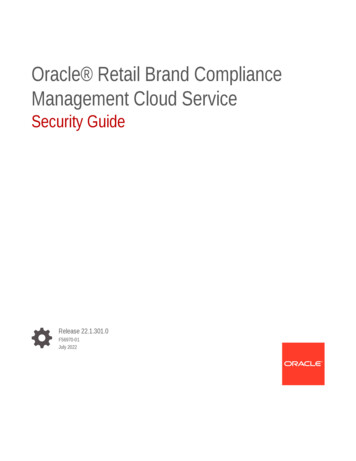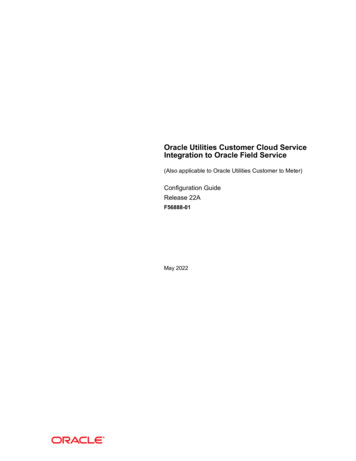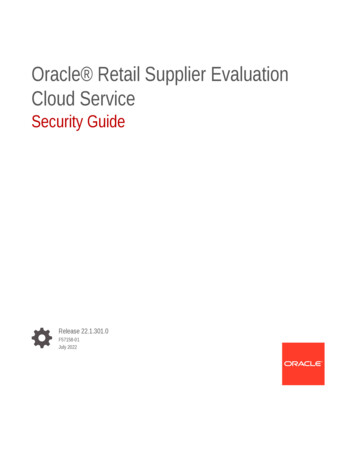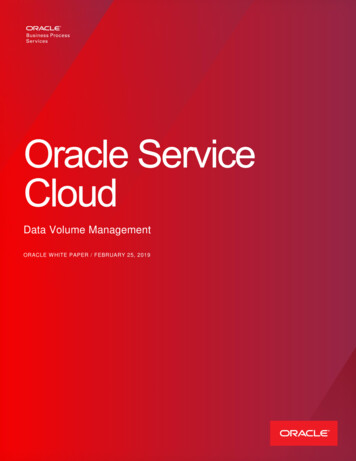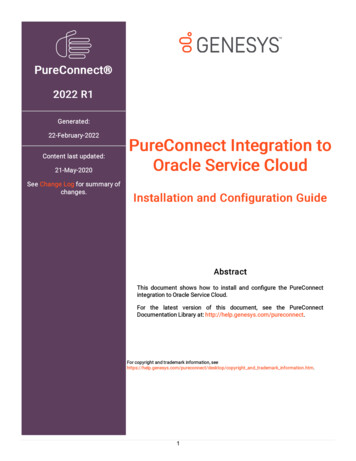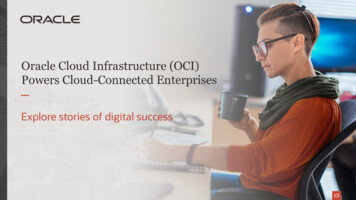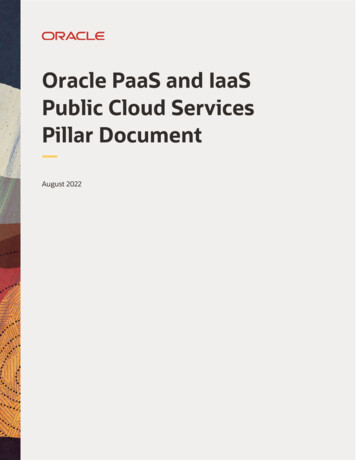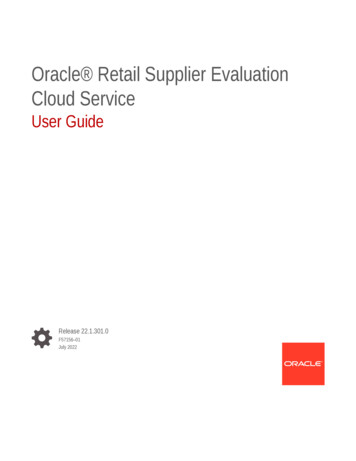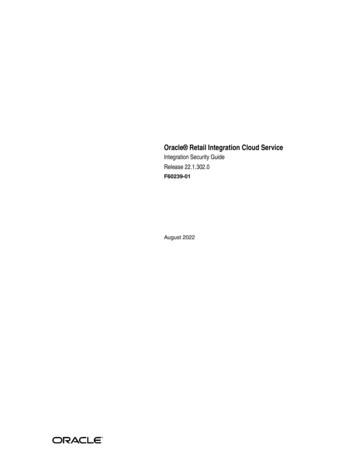
Transcription
Oracle Retail Integration Cloud ServiceIntegration Security GuideRelease 22.1.302.0F60239-01August 2022
Oracle Retail Integration Cloud Service Integration Security Guide, Release 22.1.302.0F60239-01Copyright 2022, Oracle and/or its affiliates. All rights reserved.Primary Author:Contributing Author:Contributor:This software and related documentation are provided under a license agreement containing restrictions onuse and disclosure and are protected by intellectual property laws. Except as expressly permitted in yourlicense agreement or allowed by law, you may not use, copy, reproduce, translate, broadcast, modify, license,transmit, distribute, exhibit, perform, publish, or display any part, in any form, or by any means. Reverseengineering, disassembly, or decompilation of this software, unless required by law for interoperability, isprohibited.The information contained herein is subject to change without notice and is not warranted to be error-free. Ifyou find any errors, please report them to us in writing.If this software or related documentation is delivered to the U.S. Government or anyone licensing it onbehalf of the U.S. Government, the following notice is applicable:U.S. GOVERNMENT END USERS: Oracle programs, including any operating system, integrated software,any programs installed on the hardware, and/or documentation, delivered to U.S. Government end usersare "commercial computer software" pursuant to the applicable Federal Acquisition Regulation andagency-specific supplemental regulations. As such, use, duplication, disclosure, modification, andadaptation of the programs, including any operating system, integrated software, any programs installed onthe hardware, and/or documentation, shall be subject to license terms and license restrictions applicable tothe programs. No other rights are granted to the U.S. Government.This software or hardware is developed for general use in a variety of information managementapplications. It is not developed or intended for use in any inherently dangerous applications, includingapplications that may create a risk of personal injury. If you use this software or hardware in dangerousapplications, then you shall be responsible to take all appropriate fail-safe, backup, redundancy, and othermeasures to ensure its safe use. Oracle Corporation and its affiliates disclaim any liability for any damagescaused by use of this software or hardware in dangerous applications.Oracle and Java are registered trademarks of Oracle and/or its affiliates. Other names may be trademarks oftheir respective owners.Intel and Intel Xeon are trademarks or registered trademarks of Intel Corporation. All SPARC trademarksare used under license and are trademarks or registered trademarks of SPARC International, Inc. AMD,Opteron, the AMD logo, and the AMD Opteron logo are trademarks or registered trademarks of AdvancedMicro Devices. UNIX is a registered trademark of The Open Group.This software or hardware and documentation may provide access to or information on content, products,and services from third parties. Oracle Corporation and its affiliates are not responsible for and expresslydisclaim all warranties of any kind with respect to third-party content, products, and services. OracleCorporation and its affiliates will not be responsible for any loss, costs, or damages incurred due to youraccess to or use of third-party content, products, or services.Value-Added Reseller (VAR) LanguageOracle Retail VAR ApplicationsThe following restrictions and provisions only apply to the programs referred to in this section and licensedto you. You acknowledge that the programs may contain third party software (VAR applications) licensed toOracle. Depending upon your product and its version number, the VAR applications may include:(i) the MicroStrategy Components developed and licensed by MicroStrategy Services Corporation(MicroStrategy) of McLean, Virginia to Oracle and imbedded in the MicroStrategy for Oracle Retail DataWarehouse and MicroStrategy for Oracle Retail Planning & Optimization applications.(ii) the Wavelink component developed and licensed by Wavelink Corporation (Wavelink) of Kirkland,Washington, to Oracle and imbedded in Oracle Retail Mobile Store Inventory Management.(iii) the software component known as Access Via licensed by Access Via of Seattle, Washington, andimbedded in Oracle Retail Signs and Oracle Retail Labels and Tags.(iv) the software component known as Adobe Flex licensed by Adobe Systems Incorporated of San Jose,California, and imbedded in Oracle Retail Promotion Planning & Optimization application.You acknowledge and confirm that Oracle grants you use of only the object code of the VAR Applications.Oracle will not deliver source code to the VAR Applications to you. Notwithstanding any other term orcondition of the agreement and this ordering document, you shall not cause or permit alteration of any VAR
Applications. For purposes of this section, "alteration" refers to all alterations, translations, upgrades,enhancements, customizations or modifications of all or any portion of the VAR Applications including allreconfigurations, reassembly or reverse assembly, re-engineering or reverse engineering and recompilationsor reverse compilations of the VAR Applications or any derivatives of the VAR Applications. Youacknowledge that it shall be a breach of the agreement to utilize the relationship, and/or confidentialinformation of the VAR Applications for purposes of competitive discovery.The VAR Applications contain trade secrets of Oracle and Oracle's licensors and Customer shall not attempt,cause, or permit the alteration, decompilation, reverse engineering, disassembly or other reduction of theVAR Applications to a human perceivable form. Oracle reserves the right to replace, with functionalequivalent software, any of the VAR Applications in future releases of the applicable program.
ContentsSend Us Your Comments . viiPreface . ixAudience.Documentation Accessibility .Customer Support .Improved Process for Oracle Retail Documentation Corrections .Oracle Retail Documentation on the Oracle Help Center (docs.oracle.com) .Conventions .ixixixxxx1 Introduction2 ResponsibilitiesRetailer Responsibilities. 2-1Oracle Responsibilities . 2-13 Oracle Retail SaaS SecuritySecure Product Engineering .Secure Deployment.Physical Safeguards .Network Security.Infrastructure Security .Data Security .3-13-13-23-23-23-24 Secure ManagementAssessment and Audit. 4-15 Integration Cloud Services ArchitectureArchitecture . 5-16 Integration Cloud Service Authentication and AuthorizationAuthentication and OCI IAM . 6-1OCI IAM . 6-1v
OCI IAM and Oracle Retail Enterprise Roles.OCI IAM and Application Users.Authorization .Roles.Duties and Privileges.7 Frequently Asked QuestionsG Appendix: Default Functional Security Implementationvi6-26-26-26-26-3
Send Us Your CommentsOracle Retail Integration Cloud Service Integration Security Guide, Release 22.1.302.0Oracle welcomes customers' comments and suggestions on the quality and usefulnessof this document.Your feedback is important, and helps us to best meet your needs as a user of ourproducts. For example: Are the implementation steps correct and complete? Did you understand the context of the procedures? Did you find any errors in the information? Does the structure of the information help you with your tasks? Do you need different information or graphics? If so, where, and in what format? Are the examples correct? Do you need more examples?If you find any errors or have any other suggestions for improvement, then please tellus your name, the name of the company who has licensed our products, the title andpart number of the documentation and the chapter, section, and page number (ifavailable).Before sending us your comments, you might like to checkthat you have the latest version of the document and if any concernsare already addressed. To do this, access the Online Documentationavailable on the Oracle Technology Network Web site. It contains themost current Documentation Library plus all documents revised orreleased recently.Note:Send your comments to us using the electronic mail address: retail-doc us@oracle.comPlease give your name, address, electronic mail address, and telephone number(optional).If you need assistance with Oracle software, then please contact your supportrepresentative or Oracle Support Services.If you require training or instruction in using Oracle software, then please contact yourOracle local office and inquire about our Oracle University offerings. A list of Oracleoffices is available on our Web site at http://www.oracle.com.vii
viii
PrefaceThis document serves as a guide for administrators, developers, and systemintegrators who securely administer, customize, and integrate Oracle Retail IntegrationCloud Service applications.AudienceThis document is intended for administrators, developers, and system integrators whoperform the following functions: Document specific security features and configuration details for the abovementioned product, in order to facilitate and support the secure operation of theOracle Retail Product and any external compliance standards.Guide administrators, developers, and system integrators on secure productimplementation, integration, and administration.We assume that the readers have general knowledge of administering the underlyingtechnologies and the application.Documentation AccessibilityFor information about Oracle's commitment to accessibility, visit the OracleAccessibility Program website athttp://www.oracle.com/pls/topic/lookup?ctx acc&id docacc.Access to Oracle SupportOracle customers that have purchased support have access to electronic supportthrough My Oracle Support. For information, visithttp://www.oracle.com/pls/topic/lookup?ctx acc&id info or visithttp://www.oracle.com/pls/topic/lookup?ctx acc&id trs if you arehearing impaired.Customer SupportTo contact Oracle Customer Support, access My Oracle Support at the following URL:https://support.oracle.comWhen contacting Customer Support, please provide the following: Product version and program/module name Functional and technical description of the problem (include business impact)ix
Detailed step-by-step instructions to re-create Exact error message received Screen shots of each step you takeImproved Process for Oracle Retail Documentation CorrectionsTo more quickly address critical corrections to Oracle Retail documentation content,Oracle Retail documentation may be republished whenever a critical correction isneeded. For critical corrections, the republication of an Oracle Retail document may attimes not be attached to a numbered software release; instead, the Oracle Retaildocument will simply be replaced on the Oracle Technology Network Web site, or, inthe case of Data Models, to the applicable My Oracle Support Documentationcontainer where they reside.This process will prevent delays in making critical corrections available to customers.For the customer, it means that before you begin installation, you must verify that youhave the most recent version of the Oracle Retail documentation set. Oracle Retaildocumentation is available on the Oracle Technology Network at the following n/oracle-retail-100266.htmlAn updated version of the applicable Oracle Retail document is indicated by Oraclepart number, as well as print date (month and year). An updated version uses thesame part number, with a higher-numbered suffix. For example, part numberE123456-02 is an updated version of a document with part number E123456-01.If a more recent version of a document is available, that version supersedes allprevious versions.Oracle Retail Documentation on the Oracle Help Center(docs.oracle.com)Oracle Retail product documentation is also available on the following Web index.html(Data Model documents can be obtained through My Oracle Support.)ConventionsThe following text conventions are used in this document:xConventionMeaningboldfaceBoldface type indicates graphical user interface elements associatedwith an action, or terms defined in text or the glossary.italicItalic type indicates book titles, emphasis, or placeholder variables forwhich you supply particular values.monospaceMonospace type indicates commands within a paragraph, URLs, codein examples, text that appears on the screen, or text that you enter.
1Introduction1Software as a Service (SaaS) is changing technology today. SaaS applications shiftresponsibilities from retailers and their data centers to cloud service providers. Thecloud service provider is responsible for upgrades, uptime and security. Oracleprovides many retail cloud services, including Oracle Retail Integration CloudServices.The Oracle Retail Integration Cloud Service is a suite of software-as-a service solutionsthat provides retailers with various integration solutions. This includes RetailIntegration Bus (RIB), Retail Service Bus (RSB), Bulk Data Integration (BDI), RetailFinancial Integration (RFI) and Universal Service Mapper (USM).This document is divided into six main sections: Responsibilities - The Responsibilities section of the document discusses theshared responsibility model of security.Oracle Retail SaaS Security - This section of the document outlines the policies andprocedures Oracle Retail uses to meet its security responsibilities.Integration Cloud Service Architecture - This section details the architecture of theIntegration Cloud Service, particularly as it relates to security.Integration Cloud Service Authentication, and Authorization - This sectiondescribes how Integration Cloud Service performs authentication andauthorization can be applied.Frequently Asked Questions - This section includes a number of specific questionsrelated to security that are frequently asked by prospects, customers andimplementers.The goals of this document are to: Explain the security responsibilities of Oracle and the Retailer in the SaaS model Educate retailers about Oracle's cloud security policies and controls Describe Integration Cloud Service's –general architecture, particularly as it relates to security–security featuresDefine additional steps customer IT staff must perform to communicate securelywith Integration Cloud ServiceGuide Customer administrators in the actions they need to perform to–create application users–assign roles to application usersIntroduction 1-1
Provide answers to frequently asked questions about Integration Cloud Servicesecurity1-2 Oracle Retail Integration Cloud Service Integration Security Guide
2Responsibilities2As retailers migrate to the cloud, they must consider how the cloud, and morespecifically Software-As-A-Service (SaaS), will impact their privacy, security, andcompliance efforts. As the cloud service provider, Oracle Retail works together withcustomers to meet cloud security objectivesRetailer ResponsibilitiesAt a high level, retailers are responsible for: Understanding Oracle's security policies Implementing their own corporate policies via Oracle tools Creating and administering users via Oracle tools Ensuring data quality and enforcing end-user devices security controls, so thatantivirus, malware and other malicious code checks are performed on data andfiles before uploading data Ensuring that end-user devices meet the minimum security requirements Generating public/private key pairs as requested by Oracle RetailTo securely implement Integration Cloud Service, retailers and their implementationpartners should read this document to understand Oracle's security policies. Thisdocument summarizes information and contains links to many other Oracledocuments.Oracle ResponsibilitiesAs the cloud service provider, at the highest level Oracle Retail is responsible for: building secure software provisioning and managing secure environments protecting the retailer's dataIntegration Cloud Service fulfills its responsibilities by a combination of corporatelevel development practices and cloud delivery policies. Sections in this document willdescribe this information in great detail later in this documentResponsibilities2-1
Oracle Responsibilities2-2 Oracle Retail Integration Cloud Service Integration Security Guide
3Oracle Retail SaaS Security3Security is a many faceted issue to address. To discuss Oracle Retail SaaS security, ithelps to define and categorize the many aspects of security. For the purposes of thisdocument, we discuss the following categories of SaaS security: Secure Product Engineering Secure Deployment Secure Management Assessment and AuditsSecure Product EngineeringOracle builds secure software through a rigorous set of formal, always evolvingsecurity standards and practices known as Oracle Software Security Assurance(OSSA). OSSA encompasses every phase of the product development lifecycle.More information about OSSA can be found ices/assurance/The cornerstones of OSSA are Secure Coding Standards and Security Analysis andTesting. Secure Coding Standards include both general use cases and language specificsecurity practices. More information about these practices can be found ices/assurance/development/Security Analysis and Testing includes product specific functional security testing andboth static and dynamic analysis of the code base. Static Analysis is performed viatools including both internal Oracle tools and HP's Fortify. Dynamic Analysis focuseson APIs and endpoints, using techniques like fuzzing to test interfaces and .htmlSpecific security details of the Integration Cloud Service are discussed in detail later inthis document.Secure DeploymentSecure deployment refers to the security of the infrastructure used to deploy the SaaSapplication. Key issues in secure deployment include Physical Safeguards, NetworkSecurity, Infrastructure Security and Data SecurityOracle Retail SaaS Security 3-1
Physical SafeguardsPhysical SafeguardsOracle Retail SaaS applications are deployed via Oracle Cloud Infrastructuredatacenters. Access to Oracle Cloud data centers requires special authorization that ismonitored and audited. The premises are monitored by CCTV, with entrancesprotected by physical barriers and security guards. Governance controls are in place tominimize the resources that are able to access systems. Physical security safeguards arefurther detailed in Oracle's Cloud Hosting and Delivery twork SecurityThe Oracle Cloud network is isolated from the Oracle Corporate Network. Customerinstances are separated down to the VLAN level.Infrastructure SecurityThe security of the underlying infrastructure used to deploy Oracle Retail SaaS isregularly hardened. Critical patch updates are applied on a regular schedule. Oraclemaintains a running list of critical patch updates and security alerts. Per Oracle'sCloud Hosting and Delivery Policies, these updates are applied to all Oracle ics/security/alerts-086861.htmlBefore Oracle Retail deploys code to SaaS, Oracle's Global Information Security teamperforms penetration testing on the cloud service. This penetration testing andremediation prevents software or infrastructure issues in production mlData SecurityOracle Retail uses a number of strategies and policies to ensure the Retailer's data isfully secured. Data Design - Oracle Retail applications avoid storing personal data. Where PIIdata exists in a system, Data Minimization, Right to Access and Right to Forgetservices exist to support data privacy standards.Storage - Oracle Retail applications use encrypted tablespaces to store sensitivedata.Transit - All data is encrypted in transit, Retail SaaS uses TLS for secure transportof data, as documented in Oracle's Cloud Hosting and Delivery g-delivery-policies-3089853.pdf3-2 Oracle Retail Integration Cloud Service Integration Security Guide
4Secure Management4Oracle Retail manages SaaS based on a well documented set of security-focusedStandard Operating Procedures (SOPs). The SOPs provide direction and describeactivities and tasks undertaken by Oracle personnel when delivering services tocustomers. SOPs are managed centrally and are available to authorized personnelthrough Oracle's intranet on a need-to-know basis.All network devices, servers, OS, applications and databases underlying Oracle RetailCloud Services are configured and maintain auditing and logging. All logs areforwarded to a Security Information and Event Management (SIEM) system. The SIEMis managed by the Security Engineering team and is monitored 24*7 by the GBUSecurity Operations team. The SIEM is configured to alert the GBU SecurityOperations team regarding any conditions deemed to be potentially suspicious, forfurther investigation. Access given to review logs is restricted to a subset of securityadministrators and security operations personnel only.Assessment and AuditOracle Cloud meets all ISO/IEC 27002 Codes of Practice for Information SecurityControls. Third Party Audit Reports and letters of compliance for Oracle CloudServices are periodically publishedSecure Management 4-1
Assessment and Audit4-2 Oracle Retail Integration Cloud Service Integration Security Guide
5Integration Cloud Services Architecture5Integration Cloud Service is a set of ADF-based Java applications deployed on Oracle'sGlobal Business Unit Cloud Services 3.x Platform Services. The applications aredeployed in a highly available, high performance, horizontally scalable architecture.As of release 19.1.000, Integration Cloud Services uses Oracle Identity and AccessManagement (OCI IAM) as its identity provider (IDP). Information about logical,physical and data architecture in this document focuses on how the architecturesupports security.Oracle Retail Integration Cloud Services deployment currentlyon versions 16.0.029 and lower currently use an instance of OracleIdentity Management (IDM) Suite within Integration Cloud Servicesas an IDP. As these live customers are upgraded to 16.0.030 andtransitioned to GBUCS3, their authentication will be transitioned touse OCI IAM. Oracle Retail will not move any user and groupinformation currently in the live SaaS customer's IDM suite to thecustomer's OCI IAM tenancy.Note:ArchitectureIntegration Cloud Services Architecture5-1
ArchitectureMost customer access to the Integration Cloud Service is via the web tier. The web tiercontains the perimeter network services that protect the Integration applications fromthe internet at large.All traffic from the web tier continues to the Web Tier Security Server (WTSS), whichin turn uses the customer's OCI IAM tenancy to perform authentication. Moreinformation about authentication through OCI IAM is provided later in this document.The application tier consists of several application servers. These servers provide theIntegration applications, which allows integration between Oracle retail applicationsand external applications. Retail Integration Console (RICS) is a UI component thatserves as dashboard for the integration. Retail Home is a UI component that can serveas a coordinated dashboard for many Oracle Retail cloud services.The underlying container DBaaS includes one pluggable database (PDB). Applicationsare able to access the Integration schema on the Integration PDB. Transparent dataencryption (TDE) is set during provisioning. Tablespaces that contain personal dataare encrypted.Integration Cloud Services applications integrate with external business systems via: Native ReST Services SOAP ServicesIntegration Cloud Services authenticates native rest services using OAUTH2.0 via OCIIAM. As a common authentication pattern is used, web service users are subject to thesame strong controls as application users. All rest service calls are logged in theapplication logs.Integration Cloud Service is deployed on a collection of single tenant VMs. Each VMresides in an appropriate tier and each tier resides in its own subnet. Communicationbetween tiers within the Integration Cloud Service is limited by subnet ingress securitylists.To reduce attack surface, access to the Integration Cloud Service from the open internetis very limited. Business Users (via web browser) and external web service endpointsaccess application over https/443. Firewall and load balancer in the DMZ pass trafficto the WTSS server in the Authentication Tier, which in turn to requests authentication(through outbound proxy) from the customer's OCI IAM tenancy.Within the Integration Cloud Service itself, traffic between tiers is very limited.Authenticated requests are passed from the AuthN Tier to the M-Tier. Access to theunderlying DBaaS is only available via the M-Tier.Outbound web service traffic is routed through the outbound proxy in the DMZ.A subset of Oracle Retail AMS has very limited access to the underlying DBaaS andM-Tier via Bastion host. This access is limited to a small subset of Oracle employees asdescribed in Oracle's Cloud Hosting and Delivery g-delivery-policies-3089853.pdf5-2 Oracle Retail Integration Cloud Service Integration Security Guide
6Integration Cloud Service Authentication andAuthorization6Authentication confirms the identity of a user (is this user John Smith?). Authorizationdetermines what parts of an application a user can access and what actions the usercan perform (is John Smith allowed to create a purchase order?).Authentication and OCI IAMAs of version 22.1.201.0, Integration Cloud Service uses Oracle Identity and AccessManagement (OCI IAM) as its identity provider loud-service.htmlWhen a user connects to the Integration Cloud Service UI, Integration Cloud Servicesredirects application URL requests to the OCI IAM login screen. OCI IAMauthenticates the user. When a user logs out of the Integration Cloud Service,Integration invokes an OCI IAM logout to disable session authentication.OCI IAMOCI IAM is Oracle's cloud native security and identity platform. It provides apowerful set of hybrid identity features to maintain a single identity for each useracross cloud, mobile, and on-premises applications. OCI IAM enables single sign on(SSO) across all applications in a customer's Oracle Cloud tenancy. Customers can alsointegrate OCI IAM with other on premise applications to extend the
When any Oracle Retail cloud service is provisioned, Oracle Retail's Enterprise Roles are seeded into the customer's OCI IAM instance as Roles. It is expected that customers will also have other roles defined for other cloud services that use this OCI IAM instance. OCI IAM and Application Users
